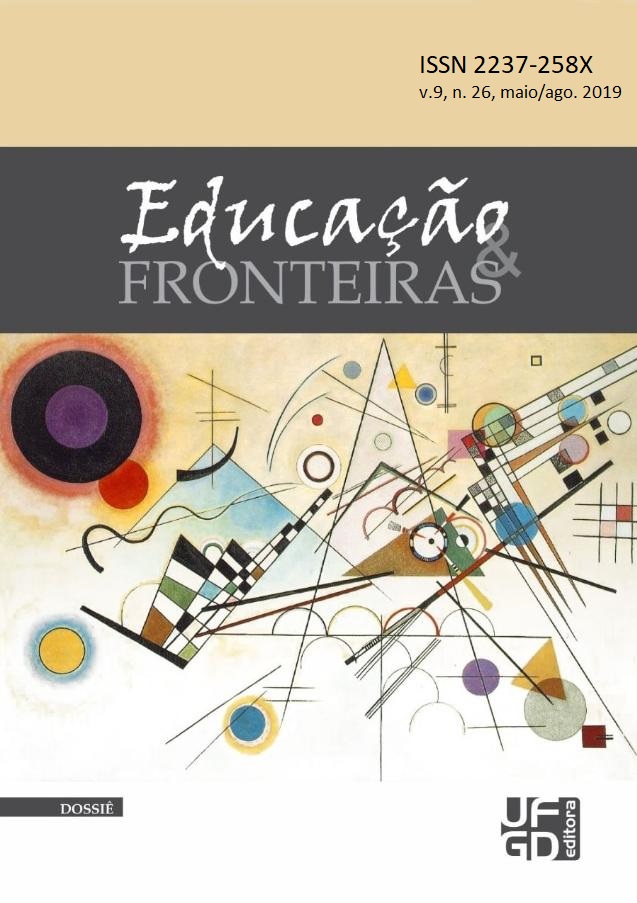Education, literacy and lettering: the Child Magazineand its Kaleidoscope Section
DOI:
https://doi.org/10.30612/eduf.v9i26.12774Keywords:
Education. Alphabetization. Literacy. Child MagazineAbstract
The aim of this paper is to show some results obtained from the mapping on the theoretical and methodological orientations of the most frequent processes on alphabetization and literacy present in the pedagogical section "Kaleidoscope" on the printed version of the Child Magazine.This journal is designed mainly for teachers of early childhood education, yet it is also available to teachers from the early years of elementary school. It is found on the website of MEC.To support this research it was used the main theoretical framework studies by Magda Soares about the processes of literacy and alphabetization.The author understands that the process of learning alphabetization as necessary for the acts of reading and writing and literacy is the state or condition of the subject that incorporates social practices of reading and writing skills. The relevance of this study lies on the contribution that it may mean for the initial andcontinuing teacher formation, since it is an important issue on the Brazilian educational context, represented, among others, by the results of Exam Brazil and the Index of Basic Education Development (IDEB).It is a bibliographical research with descriptive and interpretive character, whose analysis of the sources was performed in several stages: selection of the Child Magazine issues to be studied (number 38-46); readings and record keeping of the articles present in these issues; session definition and items to be studied and analyzed.It has been found that the thematic alphabetization and literacy, dealt with explicitly and directly, is virtually absent from the guidelines conveyed by the journal in study.Nevertheless, there are other theoretical and methodological orientations -the role of literature in the learning and development process; the relation between the care and education; evaluation; transition from primary education up to nine years teaching and curriculum -present in the journal interfere indirectly in the subject studied.Downloads
References
AMORIM, Adenice; BRITO, Mônica; BARROS, Siriene. Pare! Respeite-me, também sou cidadão! Revista Criançado Professor de Educação Infantil, Brasília, DF: MEC, n. 39, p. 15-17, abr. 2005.
ARAGÃO, Rosana. O portfólio como novo instrumento de avaliação. Revista Criança do Professor de Educação Infantil, Brasília, DF: MEC, n. 41, p. 14-17, nov. 2006.
BEAUCHAMP, Jeanete. Integração de creches e pré-escolas e habilitação de professores: qualidade na Educação Infantil. Revista Criança do Professor de Educação Infantil, Brasília, DF: MEC, n. 39, p. 10-11, abr. 2005.
BORBA, Angela. A brincadeira como experiência de cultura na educação infantil. Revista Criança do Professor de Educação Infantil, Brasília, DF: MEC, n. 44, p. 12-14, nov. 2007.
CAMARGO, Fátima. Criança e educação: uma trajetória cultural e institucional. Revista Criança do Professor de Educação Infantil, Brasília, DF: MEC, n. 39, p. 12-14, abr. 2005.
COELHO, Nelly. O Conto de Fadas. Revista Criança do Professor de Educação Infantil, Brasília, DF: MEC, n. 38, p. 10-12, jan. 2005.
COUTINHO, Angela; ROCHA, Eloisa. Bases curriculares para a educação infantil? Ou isto ou aquilo. Revista Criança do Professor de Educação Infantil, Brasília, DF: MEC, n. 43, p. 10-11, ago. 2007.
FERNANDES, Claudia. Avaliação sempre envolve uma concepção de mundo. In: BRASIL. Revista Criança do professor de educação infantil. MEC, nov. 2006, n. 41, p. 9-11.
FRADE, I.C.A.S. Revistas pedagógicas: qual é a identidade do impresso? s/d. In: GALVÃO, A.M.O; BATISTA, A. A.G (Orgs). Leitura: práticas, impressos e letramento. Belo Horizonte: Autêntica, 2011.
GUEDES, Adriane. A comunicação com bebês e com crianças pequenas: A imitação como forma de conhecer o mundo. In: BRASIL. Revista Criança do professor de educação infantil. MEC, dez. 2006, n. 46, p. 10-13.
JUNQUEIRA FILHO, Gabriel de A. Os conteúdos em educação infantil. In: BRASIL. Revista Criança do professor de educação infantil. MEC, ago. 2007, n. 43, p. 12-13.
LIMA, Elvira. A criança de 6 anos no Ensino Fundamental. In: BRASIL. Revista Criança do professor de educação infantil. MEC, dez. 2006, n. 42, p. 12-15.
LOPES, Karina; MENDES, Roseana. Desafios de um novo tempo. In: BRASIL. Revista Criança do professor de educação infantil. MEC, dez. 2006, n. 42, p. 8-9.
NASCIMENTO, Anelise. Currículo e práticas pedagógicas na educação infantil. In: BRASIL. Revista Criança do professor de educação infantil. MEC, ago. 2007, n. 43, p. 14-17.
OLIVEIRA, Wanessa Gorri. A imprensa pedagógica como fonte e objeto para uma escrita da história da educação: em destaque a Prática pedagógica sugerida ao professor de educação infantil pela Revista Criança (1996-2006). 2011. 198 f. Dissertação (mestrado em Educação) -Universidade Estadual de Maringá, Maringá.
PAGEL, Sandra; NASCIMENTO, Aricélia. A criança de 6 anos no ensino Obrigatório: Um avanço social. In: BRASIL. Revista Criança do professor de educação infantil. MEC, dez. 2006, n. 42, p. 10-11.
PEDROSA, Eliane; ABREU, Rosa. Alfabetização e letramento: A experiência de São Luís. In: BRASIL. Revista Criança do professor de educação infantil. MEC, nov. 2007, n. 44, p. 10-11.
ROCHA, A.S.; BERNARDO, D. G. Pesquisa bibliográfica: entre conceitos e fazeres. In: TOLEDO, C. A. A.; GONZAGA, M. T. C. (org.). Metodologia e técnicas nas áreas de Ciências Humanas.Maringá: EDUEM, 2001. p. 101-119.
SOARES, Magda. Alfabetização e letramento. São Paulo: Contexto, 2010.SOARES, Magda. Letramento e alfabetização: as muitas facetas. Letrar é mais que Alfabetizar. Jornal do Brasil. São Paulo, 2001.
VIEIRA, Isabel. O papel dos Contos de Fadas na Construção do Imaginário Infantil. In: BRASIL. Revista Criança do professor de educação infantil. MEC, jan. 2005, n. 38, p. 8-9l.









